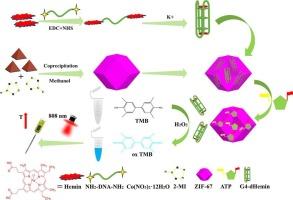Photothermal ATP detection by competitive displacement of ZIF-67 adsorbed G4-dHemin DNAzyme
IF 4.9
2区 化学
Q1 CHEMISTRY, ANALYTICAL
引用次数: 0
Abstract
Adenosine triphosphate (ATP) is the primary energy currency in biological system. Abnormal ATP levels are closely related to physical disease. There are series of shortcomings of traditional ATP detection methods, such as complex sample preparation, expensive analysis cost, lack of specificity. Therefore, it is extremely important to establish a convenient and simple ATP monitoring method. Herein, we propose a photothermal biosensing strategy utilizing zeolitic imidazolate framework-67 (ZIF-67) and G4-dHemin DNAzyme for both precise and selective ATP quantification. This platform enables the detection of ATP through a novel competitive displacement mechanism, and achieves higher specificity and lower costs than the traditional method without relying on the aptamer. ZIF-67 has ultrahigh selectivity for recognizing ATP, and G4-dHemin DNAzyme exhibits oxidase-like activity which can effectively oxidize TMB. In this work, G4-dHemin DNAzyme was adsorbed by ZIF-67 due to the electrostatic effect. As a result, the oxidase-like activity of G4-dHemin DNAzyme was greatly reduced. The presence of ATP released the G4-dHemin DNAzyme from ZIF-67, allowing the restore of oxidase-like activity of G4-dHemin DNAzyme. Thus, the colorless TMB could be effectively oxidized to blue substrates (ox TMB). ox TMB, as an excellent photothermal agent, converted the optical signal into a thermal signal (temperature increasing) driven by an 808 nm laser (2.45 W). Then, the photothermal and color signal variations were easily monitored by a portable thermometer and a smartphone. The minimum detection limit of this method was calculated to be 0.41 μM, which could meet the detection of ATP in real samples.

ZIF-67吸附G4-dHemin DNAzyme的竞争置换光热ATP检测
三磷酸腺苷(ATP)是生物系统的主要能量货币。ATP水平异常与躯体疾病密切相关。传统的ATP检测方法存在样品制备复杂、分析成本昂贵、特异性不足等一系列缺点。因此,建立一种方便、简单的ATP监测方法显得尤为重要。在此,我们提出了一种利用沸石咪唑酸框架-67 (ZIF-67)和G4-dHemin DNAzyme进行精确和选择性ATP定量的光热生物传感策略。该平台通过一种新颖的竞争位移机制实现ATP的检测,在不依赖适配体的情况下,实现了比传统方法更高的特异性和更低的成本。ZIF-67具有超高的ATP识别选择性,G4-dHemin DNAzyme具有类似氧化酶的活性,能有效氧化TMB。在本研究中,由于静电效应,G4-dHemin DNAzyme被ZIF-67吸附。结果,G4-dHemin DNAzyme的类氧化酶活性大大降低。ATP的存在使G4-dHemin DNAzyme从ZIF-67中释放出来,使g4 - DNAzyme恢复了类似氧化酶的活性。因此,无色TMB可以有效地被氧化为蓝色底物(ox TMB)。ox TMB作为一种优良的光热剂,在808 nm (2.45 W)激光的驱动下,将光信号转化为温度升高的热信号。然后,通过便携式温度计和智能手机轻松监测光热和颜色信号的变化。计算出该方法的最小检出限为0.41 μM,可以满足实际样品中ATP的检测要求。
本文章由计算机程序翻译,如有差异,请以英文原文为准。
求助全文
约1分钟内获得全文
求助全文
来源期刊

Microchemical Journal
化学-分析化学
CiteScore
8.70
自引率
8.30%
发文量
1131
审稿时长
1.9 months
期刊介绍:
The Microchemical Journal is a peer reviewed journal devoted to all aspects and phases of analytical chemistry and chemical analysis. The Microchemical Journal publishes articles which are at the forefront of modern analytical chemistry and cover innovations in the techniques to the finest possible limits. This includes fundamental aspects, instrumentation, new developments, innovative and novel methods and applications including environmental and clinical field.
Traditional classical analytical methods such as spectrophotometry and titrimetry as well as established instrumentation methods such as flame and graphite furnace atomic absorption spectrometry, gas chromatography, and modified glassy or carbon electrode electrochemical methods will be considered, provided they show significant improvements and novelty compared to the established methods.
 求助内容:
求助内容: 应助结果提醒方式:
应助结果提醒方式:


